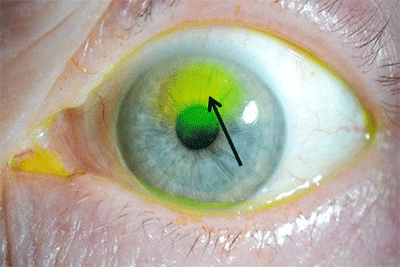Ophthalmology
-
Learning Units
- Unit 1: Sudden Loss of Vision
- Unit 2: Visual field defects, double vision & optic disc swelling
- Unit 3: Pupil abnormalities, Facial nerve palsy & Ptosis
- Unit 4: Refractive Error
- Unit 5: Children & Squint
- Unit 6: Differential diagnosis of blurred vision
- Unit 7: Gradual Loss of Vision
- Unit 8: Eye Trauma
- Unit 9: Red Eye
- Unit 10: Systemic Disease
- Useful Links
- KEATS
- KCL website
- Contact Us
2: Corneal Abrasion
Causes
- Foreign bodies
- Fingernails
- Contact lenses
Symptoms
- Pain
- Photophobia
- Foreign body sensation
- Watering

Adapted from an image uploaded to retinagallery.com by Jason Calhoun. Mayo Clinic Jacksonville.
Signs
- Corneal epithelial staining with fluorescein [see image]
- Conjunctival injection
- Swollen eyelid
© Faculty of Life Sciences & Medicine, Faculty Education Services, Digital Education Team. King's College London.
This module was prepared by C. Petrarca and T. Jackson and they retain the intellectual property rights in relation to its contents. The contents of this module must not be reproduced, or used outside King's, without their permission.
